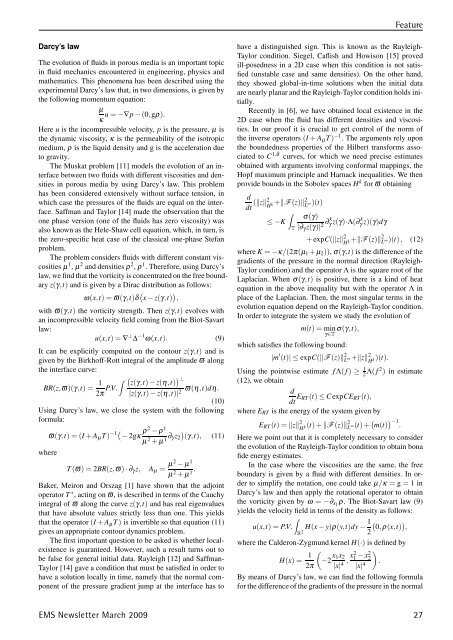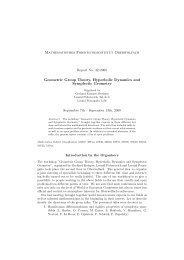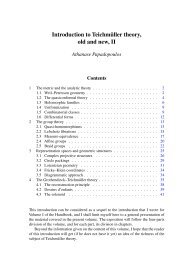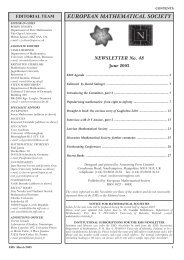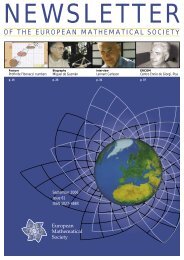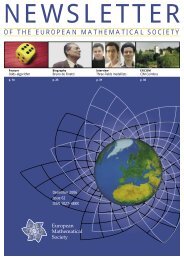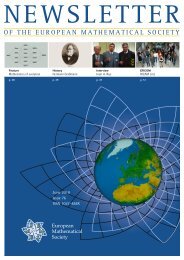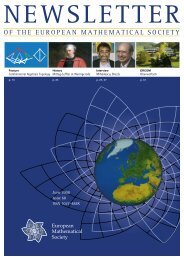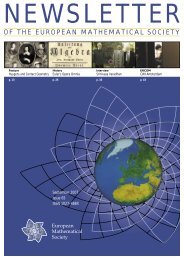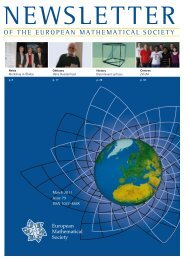New from Springer - European Mathematical Society Publishing ...
New from Springer - European Mathematical Society Publishing ...
New from Springer - European Mathematical Society Publishing ...
Create successful ePaper yourself
Turn your PDF publications into a flip-book with our unique Google optimized e-Paper software.
Darcy’s law<br />
The evolution of fluids in porous media is an important topic<br />
in fluid mechanics encountered in engineering, physics and<br />
mathematics. This phenomena has been described using the<br />
experimental Darcy’s law that, in two dimensions, is given by<br />
the following momentum equation:<br />
µ<br />
u = −∇p − (0,gρ).<br />
κ<br />
Here u is the incompressible velocity, p is the pressure, µ is<br />
the dynamic viscosity, κ is the permeability of the isotropic<br />
medium, ρ is the liquid density and g is the acceleration due<br />
to gravity.<br />
The Muskat problem [11] models the evolution of an interface<br />
between two fluids with different viscosities and densities<br />
in porous media by using Darcy’s law. This problem<br />
has been considered extensively without surface tension, in<br />
which case the pressures of the fluids are equal on the interface.<br />
Saffman and Taylor [14] made the observation that the<br />
one phase version (one of the fluids has zero viscosity) was<br />
also known as the Hele-Shaw cell equation, which, in turn, is<br />
the zero-specific heat case of the classical one-phase Stefan<br />
problem.<br />
The problem considers fluids with different constant viscosities<br />
µ 1 , µ 2 and densities ρ2 , ρ1 . Therefore, using Darcy’s<br />
law, we find that the vorticity is concentrated on the free boundary<br />
z(γ,t) and is given by a Dirac distribution as follows:<br />
ω(x,t)=ϖ(γ,t)δ � x − z(γ,t) � ,<br />
with ϖ(γ,t) the vorticity strength. Then z(γ,t) evolves with<br />
an incompressible velocity field coming <strong>from</strong> the Biot-Savart<br />
law:<br />
u(x,t)=∇ ⊥ ∆ −1 ω(x,t). (9)<br />
It can be explicitly computed on the contour z(γ,t) and is<br />
given by the Birkhoff-Rott integral of the amplitude ϖ along<br />
the interface curve:<br />
BR(z,ϖ)(γ,t)= 1<br />
2π P.V.<br />
� � z(γ,t) − z(η,t) �⊥ ϖ(η,t)dη.<br />
|z(γ,t) − z(η,t)| 2<br />
(10)<br />
Using Darcy’s law, we close the system with the following<br />
formula:<br />
ϖ(γ,t)=(I + AµT ) −1� − 2gκ ρ2 − ρ1 µ 2 �<br />
∂γz2 (γ,t), (11)<br />
+ µ 1<br />
where<br />
T (ϖ)=2BR(z,ϖ) · ∂γz, Aµ = µ2 − µ 1<br />
. 1<br />
µ 2 + µ<br />
Baker, Meiron and Orszag [1] have shown that the adjoint<br />
operator T ∗ , acting on ϖ, is described in terms of the Cauchy<br />
integral of ϖ along the curve z(γ,t) and has real eigenvalues<br />
that have absolute values strictly less than one. This yields<br />
that the operator (I + AµT) is invertible so that equation (11)<br />
gives an appropriate contour dynamics problem.<br />
The first important question to be asked is whether localexistence<br />
is guaranteed. However, such a result turns out to<br />
be false for general initial data. Rayleigh [12] and Saffman-<br />
Taylor [14] gave a condition that must be satisfied in order to<br />
have a solution locally in time, namely that the normal component<br />
of the pressure gradient jump at the interface has to<br />
Feature<br />
have a distinguished sign. This is known as the Rayleigh-<br />
Taylor condition. Siegel, Caflish and Howison [15] proved<br />
ill-posedness in a 2D case when this condition is not satisfied<br />
(unstable case and same densities). On the other hand,<br />
they showed global-in-time solutions when the initial data<br />
are nearly planar and the Rayleigh-Taylor condition holds initially.<br />
Recently in [6], we have obtained local existence in the<br />
2D case when the fluid has different densities and viscosities.<br />
In our proof it is crucial to get control of the norm of<br />
the inverse operators (I + AµT ) −1 . The arguments rely upon<br />
the boundedness properties of the Hilbert transforms associated<br />
to C 1,δ curves, for which we need precise estimates<br />
obtained with arguments involving conformal mappings, the<br />
Hopf maximum principle and Harnack inequalities. We then<br />
provide bounds in the Sobolev spaces H k for ϖ obtaining<br />
d<br />
dt (�z�2 Hk +�F (z)� 2 L∞)(t) �<br />
≤−K<br />
EMS <strong>New</strong>sletter March 2009 27<br />
T<br />
σ(γ)<br />
|∂γz(γ)| 2 ∂ k γ z(γ)·Λ(∂ k γ z)(γ)dγ<br />
+ expC(�z� 2<br />
Hk +�F (z)� 2 L∞)(t), (12)<br />
where K = −κ/(2π(µ1 + µ2)), σ(γ,t) is the difference of the<br />
gradients of the pressure in the normal direction (Rayleigh-<br />
Taylor condition) and the operator Λ is the square root of the<br />
Laplacian. When σ(γ,t) is positive, there is a kind of heat<br />
equation in the above inequality but with the operator Λ in<br />
place of the Laplacian. Then, the most singular terms in the<br />
evolution equation depend on the Rayleigh-Taylor condition.<br />
In order to integrate the system we study the evolution of<br />
m(t)=min<br />
γ∈T σ(γ,t),<br />
which satisfies the following bound:<br />
|m ′ (t)|≤expC(�F (z)� 2 L∞ +�z�2 Hk)(t). Using the pointwise estimate f Λ( f ) ≥ 1 2 Λ( f 2 ) in estimate<br />
(12), we obtain<br />
d<br />
dt ERT (t) ≤ C expCERT (t),<br />
where ERT is the energy of the system given by<br />
ERT (t)=�z� 2<br />
H k(t)+�F (z)� 2 L ∞(t)+� m(t) � −1 .<br />
Here we point out that it is completely necessary to consider<br />
the evolution of the Rayleigh-Taylor condition to obtain bona<br />
fide energy estimates.<br />
In the case where the viscosities are the same, the free<br />
boundary is given by a fluid with different densities. In order<br />
to simplify the notation, one could take µ/κ = g = 1in<br />
Darcy’s law and then apply the rotational operator to obtain<br />
the vorticity given by ω = −∂x1ρ. The Biot-Savart law (9)<br />
yields the velocity field in terms of the density as follows:<br />
�<br />
1 � �<br />
u(x,t)=P.V. H(x − y)ρ(y,t)dy− 0,ρ(x,t) ,<br />
R2 2<br />
where the Calderon-Zygmund kernel H(·) is defined by<br />
H(x)= 1<br />
�<br />
−2<br />
2π<br />
x1x2<br />
|x| 4 , x21 − x22 |x| 4<br />
�<br />
.<br />
By means of Darcy’s law, we can find the following formula<br />
for the difference of the gradients of the pressure in the normal


